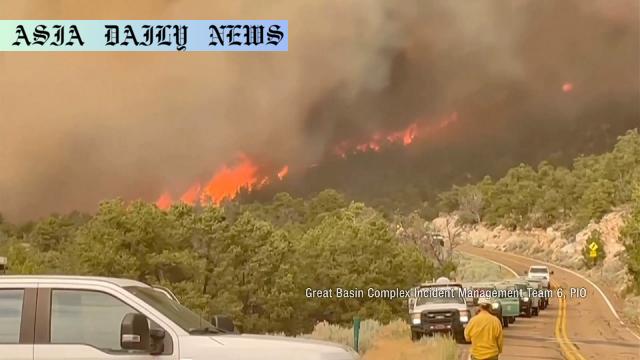Wildfire: A rapidly spreading blaze at Grand Canyon National Park in Arizona has forced the closure of its North Rim for the season.

Wildfire Ignites at Grand Canyon’s North Rim
A rapidly spreading wildfire engulfed the North Rim of Grand Canyon National Park in Arizona, causing irreparable damage and forcing authorities to close the area for the remainder of the 2025 visitor season. Ignited by a lightning strike on July 4, the blaze has since ravaged over 37 square kilometers of pristine forest and canyon land, destroying more than 70 structures, including a historic lodge and several cabins that were emblematic of the park’s rich heritage.
The Damage: Structures Lost and Smoke Spread
As of Wednesday, satellite images released by Reuters show the far-reaching impact of the fire, with smoke spreading widely across the Grand Canyon. The destruction of key facilities highlights the devastating nature of the blaze, not only for the environment but also for tourism and local economies. While the South Rim remains open to visitors, the closure of the North Rim—a popular destination for its natural beauty—has disrupted plans for countless visitors and raised concerns about long-term restoration efforts.
Response and Controversy
Arizona Governor Katie Hobbs expressed dissatisfaction with how federal authorities managed the fire, particularly their decision to approach it as a controlled burn despite the hot and dry weather conditions. In her statement on Sunday, she called for an independent investigation into the fire management strategy to ensure that lessons are learned and similar scenarios can be managed more effectively in the future. This incident underscores the challenges of balancing ecological management with public safety and preservation of natural wonders.
Impact on Tourism and Local Economy
The closure of the North Rim for the 2025 season will have a significant economic impact on local businesses reliant on tourism. Hotels, restaurants, and tour operators stand to lose revenue as visitors alter their plans. Grand Canyon National Park is one of the United States’ most iconic landmarks, drawing millions of visitors annually, and the fire’s repercussions are likely to resonate beyond the immediate vicinity.
Restoration and Environmental Concerns
Looking ahead, restoration efforts will be pivotal in healing the scars left by the wildfire. Rehabilitating the landscape while preserving its natural beauty will require meticulous planning and collaboration among experts. Additionally, the incident raises urgent questions about climate change’s role in intensifying wildfires and the need for proactive strategies to mitigate these risks.
The Grand Canyon’s enduring resilience will undoubtedly shine through this tragedy, but this wildfire serves as a sobering reminder of nature’s power and the importance of preserving our planet’s most treasured landmarks.
Commentary
Human Impact and Emotional Toll
The wildfire that has ravaged the Grand Canyon’s North Rim is a devastating reminder of how unpredictable and overwhelming nature can be. Beyond the physical damage to the landscape and structures, there is a profound emotional toll on those who hold this national treasure close to their hearts. For many visitors, the historic lodge and cabins were more than just buildings—they were gateways to unforgettable memories. Their destruction feels almost like losing a part of history, a tangible connection to the past.
The Challenge of Fire Management
The controversy surrounding the federal government’s decision to manage this fire as a controlled burn is a complex issue. On the one hand, controlled burns are essential tools for reducing fuel buildup and preventing catastrophic wildfires. On the other hand, employing such strategies during hot, dry weather is a gamble that doesn’t always pay off. This incident highlights the need for more adaptive, climate-aware fire management practices, particularly as climate change continues to exacerbate wildfire risks.
Resilience and the Path Forward
While the damage inflicted by the blaze is severe, the Grand Canyon’s history is one of resilience and renewal. Restoration efforts will undoubtedly be extensive, requiring collaboration between local, state, and federal agencies. These initiatives will not only aim to repair the damage but also to implement preventive measures to protect against future events. For visitors, this period of rehabilitation should serve as a reminder to cherish and respect our natural landscapes, understanding that they are both beautiful and fragile.
Ultimately, the Grand Canyon community—along with its dedicated visitors—will rally together to overcome this tragedy. While the scars of the wildfire will take time to heal, the lessons learned from this incident will shape a more mindful approach to preserving and protecting this majestic landmark for generations to come.


